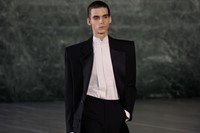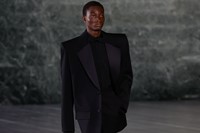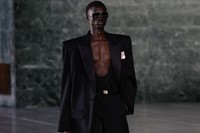The sun had started to slip down as Anthony Vaccarello’s models began to saunter out into the giant polished marble hall of Berlin’s Neue Nationalgalerie to show his Spring/Summer 2024 menswear collection. It’s by Ludwig Mies van der Rohe – from 1968, the modernist master’s final commission completed a year before his death – and a whole wall is glass, which meant the Bellini-coloured sky looked like a massive moving Rothko, roiling behind the stiletto-slender, pencil-black slashes of Vaccarello’s models.
They were appropriately inappropriately attired, meaning Vaccarello opened this Saint Laurent show with a clutch of Les Smokings – white tied tuxedo looks in featherlight grain de poudre – traditional after-dark show closers that, here, seemed perfectly in place. Not just because night was falling but because this was Saint Laurent, and this was Berlin. The openers seemed homages to Berlin’s honorary patron saint Marlene Dietrich; one model, virulent auburn hair slicked back above an ivory coeur-croisé faille top, was a dead ringer for Bowie in his Thin White Duke era, whose tail-end expired in West Berlin. It’s unsure if Vaccarello was consciously aiming for those references, or if they’re just what comes through osmosis, through showing in that city and through working for Saint Laurent. After all, Yves’ 60s tuxedos were created, in part, in homage to Dietrich’s masc drag of the 30s. Annoyingly, he showed his first tuxedo in 1966, beating Mies van der Rohe’s museum by a couple of years. Would’ve been a satisfying bit of synergy, that.
“She has sex but no positive gender,” wrote the critic Kenneth Tynan of Dietrich – and in the 30s Dietrich pushed the boundaries beyond. She was threatened with arrest and expulsion from the city of Paris for wearing men’s clothes. A Saint Laurent Le Smoking, even in the 60s, could still raise hackles – one wound up getting the socialite Nan Kempner turned away from a fancy Manhattan restaurant as inappropriately dressed (she dropped her trousers and walked in wearing just the jacket which, bizarrely, was deemed more acceptable). These days, the blurring of genders is totally complete.
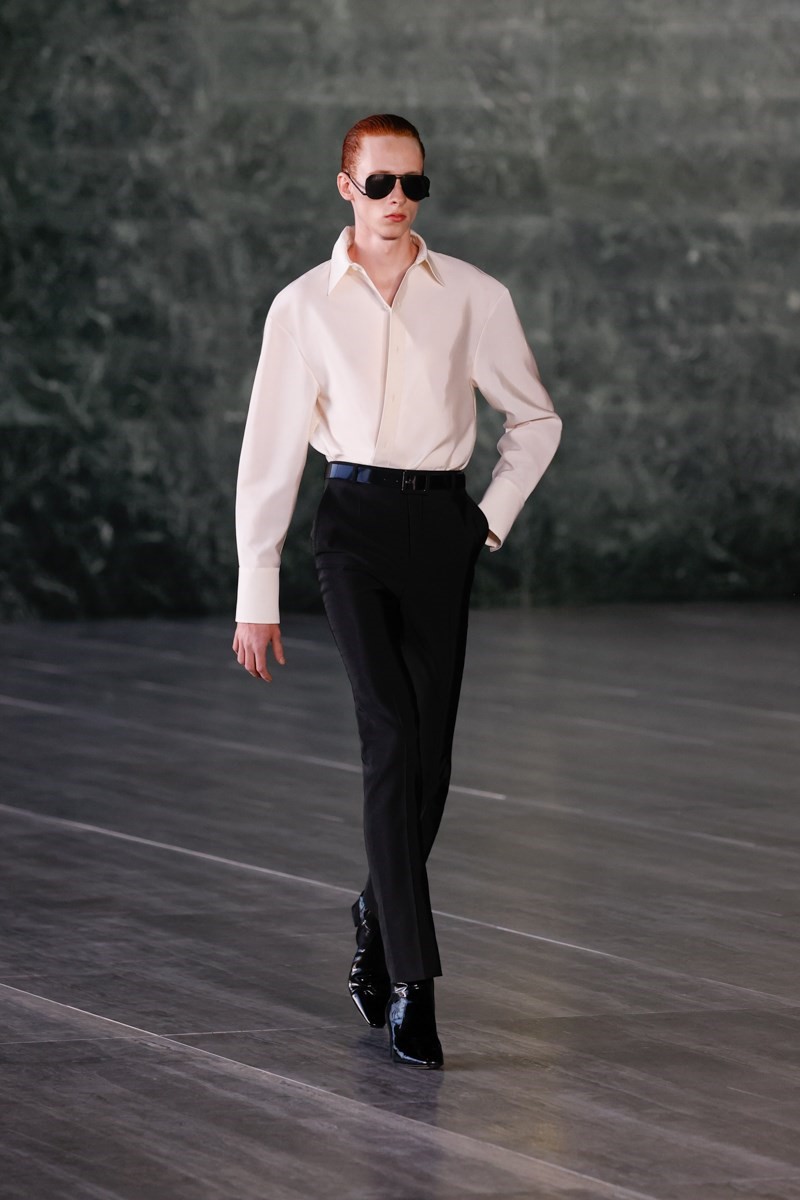
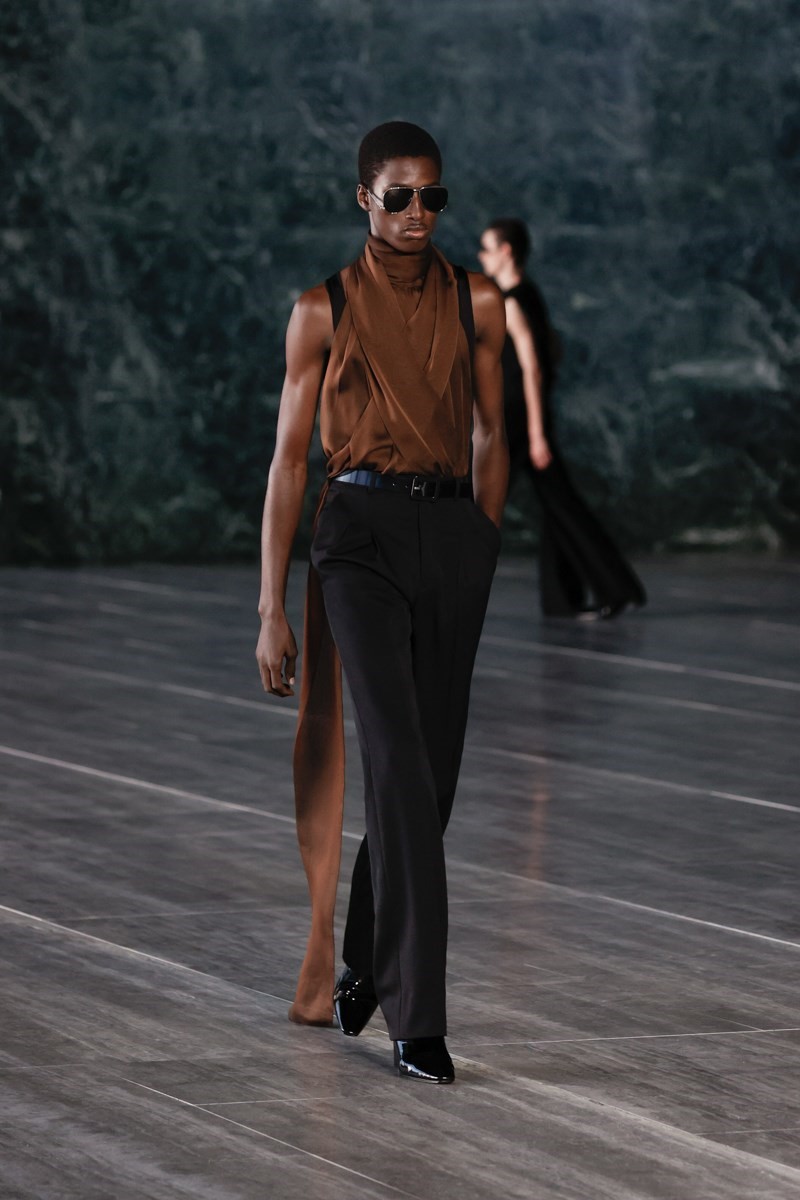
“To play with the codes of femininity and masculinity,” said Vaccarello. “I don’t know the limit between.” He was backstage before this show, eyes trained on the shoulders of his model line-up. And, I mean, we call this menswear – and it was worn by men – but really anything goes. Those shoulders were either squared-off, linebacker-wide, or fragile and sloping, deltoids exposed by blouses and bowed transparent chiffon, seductive cutaways and the kind of shrugged-off fichu necklines usually reserved for slithering evening dresses. “More couture, more refined, more delicate,” he said. Vaccarello was outright borrowing from his Saint Laurent women – look four, for instance, was a dead-ringer of a look from his stellar February show, squared-off pinstriped shoulder, slithery deep-cut vest, red pocket-square and all. He said that, although that woman was deeply Parisian, “She was two steps from being in Berlin, she reminded you of a film from Fassbinder.” So she became a he, and wound up marauding around a massive Mies van der Rohe mausoleum.
But, hold up – hadn’t that woman already borrowed her look from the Saint Laurent man, via Monsieur Saint Laurent himself who borrowed his shoulder from menswear to paradoxically assert femininity through masculinity? And Vaccarello’s men looked empowered and sensual dressed in silks and chiffons, while, apparently, now women are buying the men’s looks too … Daphne Guinness texted me and said she loved this show. So there’s a great, glorious sloppy mass of gender fluidity all about this show, all the more satisfying because it’s so unintentional, so unselfconscious, and so au naturale.
One of the remarkable things about Vaccarello’s Saint Laurent shows – and I do feel like they’re remarkable, more so season after season – is how, despite being a behemoth label keenly attuned to the modern marketing realities of 21st-century fashion, these shows are pure, unadulterated fashion experiences. It doesn’t feel like it’s about pumping out product, rather proposing a vision. “I’m from the old school,” Vaccarello said. “For me, fashion … it’s not something that has to talk necessarily to everyone.” He paused. “I do it for people who love fashion.”

